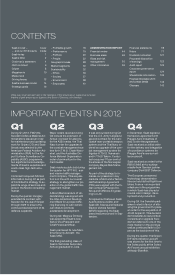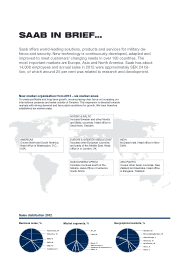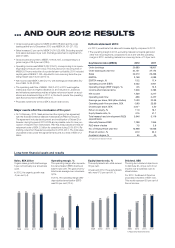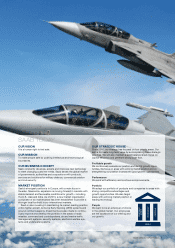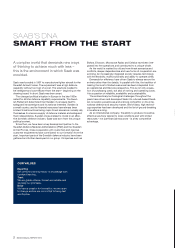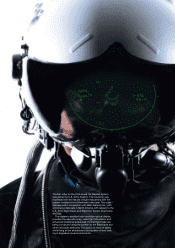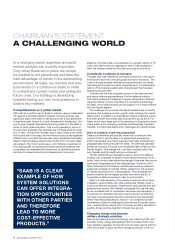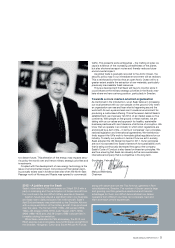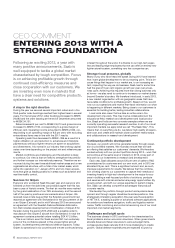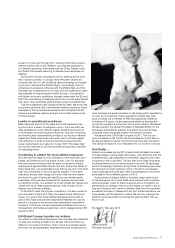Saab 2012 Annual Report Download - page 9
Download and view the complete annual report
Please find page 9 of the 2012 Saab annual report below. You can navigate through the pages in the report by either clicking on the pages listed below, or by using the keyword search tool below to find specific information within the annual report.
SAAB ANNUAL REPORT 2012 5
too distant future. This alteration of the energy map impacts secu-
rity policy the world over and hence military strategic priorities and
investments.
Coupled with the development of new energy technology is the
issue of environmental impact. Concrete proof that global warm-
ing actually exists was in evidence last year when the North-East
Passage north of Norway and Russia was opened to commercial
trafc. This presents some ambiguities – the melting of polar ice
caps is evidence of the increasing unhealthiness of the planet,
but also shortens transport routes and thereby reduces future
environmental impact.
As global trade is gradually rerouted to the Arctic Ocean, the
security policy map in our immediate environment will be redrawn.
This is reinforced by the fact that an open Arctic Ocean will to a
greater extent enable the extraction of raw materials, particularly
previously inaccessible fossil resources.
This is a development that Saab will have to monitor since it
could inuence the military strategic priorities in the Nordic mar-
kets where we have a strong position, particularly in Sweden.
Towards a more market-oriented organisation
As mentioned in the introduction, we at Saab believe in increasing
our local presence with our own people on the ground. Only when
an organisation can see and hear what is happening around the
world with its own eyes and ears can it create an environment for
producing a customised offering. This is the reason behind Saab’s
establishment, as of January 1st 2013, of six market areas on ve
continents. With people on the ground in these markets, we are
taking with us our values and approach for healthy, sustainable
business practices with zero tolerance of all forms of corruption. We
know that we operate in an industry in which strict regulations are
and should be a fact of life – in terms of companies’ own principles,
national legislation and international agreements. We therefore ac-
tively support the UN’s work to formulate global regulations for our
industry. To clarify our position in terms of how we act in society,
Saab adopted the UN Global Compact in 2011. Its ten principles
are now incorporated into Saab’s framework for sustainability work
that is being continuously developed throughout the company.
Saab’s Code of Conduct is also based on these ten principles. We
are thus ensuring that Saab can develop further as a sustainable,
international company that is competitive in the long term.
Stockholm, February 2013
Marcus Wallenberg
Chairman
2012 – A jubilee year for Saab
Saab’s celebrated its 75th anniversary on 2 April 2012 with a
party in Linköping and the participation of Gripen aircraft from
four countries in the Lion Effort military exercise in Sweden.
Aviation has always played a signicant role in our business,
and Saab has to date produced over 4,000 aircraft. Saab’s
April 2nd anniversary was celebrated by the Swedish Airforce
with a unique exhibition of the military aircraft it has produced
over the years. The Tunnan (1951-1956), J32 Lansen (1956-
1960), J35 Draken (1959-1977), AJ37 Viggen (1971-1990),
SK60 (1966-1972) and JAS 39 Gripen (1993-) aircraft ew in
formation during the exhibition.
While Saab celebrated its 75th anniversary, the 2012 Lion
Effort exercise was in progress. Around 30 Gripen aircraft from
the Swedish, Hungarian, Czech and South African Air Forces,
along with observers from the Thai Airforce, gathered in Ron-
neby/Karlskrona, Sweden. The number of Gripen users is large
and growing, and this generates operational and nancial
advantages for them. Lion Effort demonstrates how Gripen
operators from different countries can cooperate, train and
learn from each other’s experiences.


